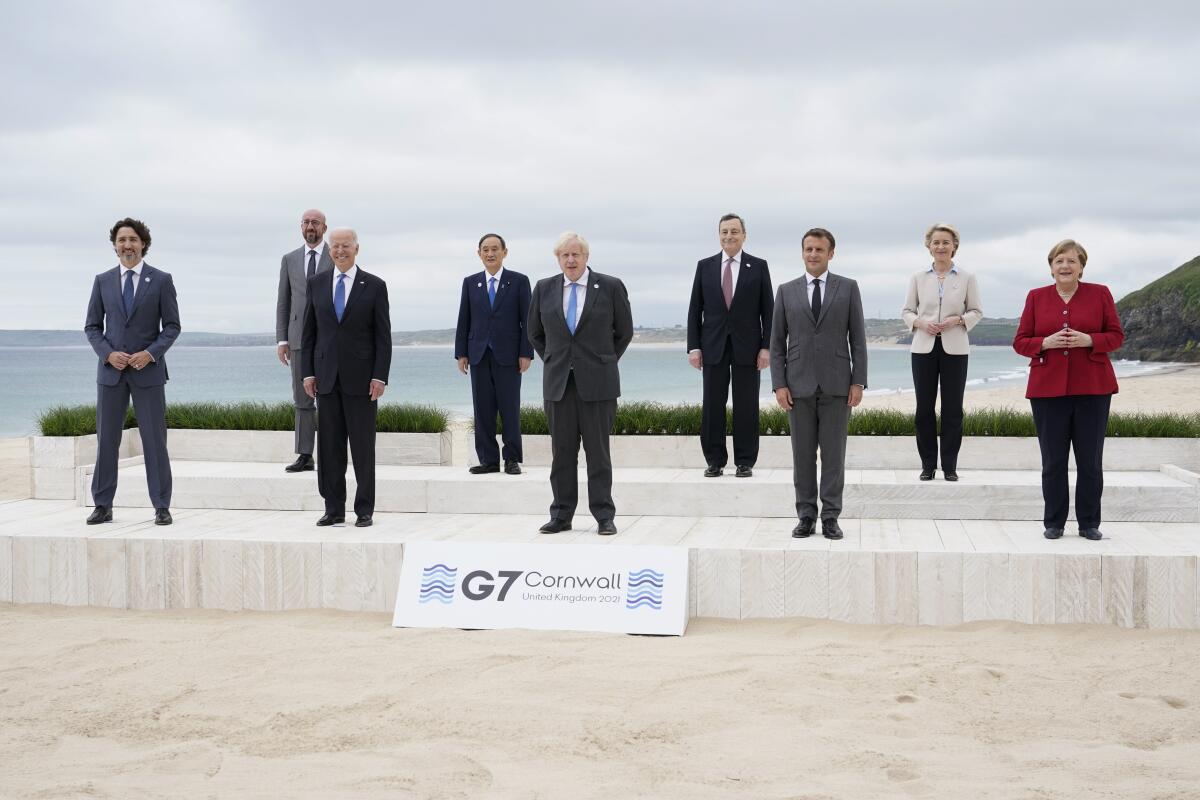Op-Ed: We don’t need any more useless G-7 summits

- Share via
The latest Group of 7 summit was a waste of resources. If it had to be held at all, it should have been conducted online, saving time, logistical costs and airplane emissions. But, more fundamentally, G-7 summits are an anachronism.
There was absolutely nothing at the G-7summit that could not have been accomplished much more cheaply, easily and routinely by Zoom. Online international meetings by politicians, parliamentarians, scientists and activists are important. They normalize international discussions.
But why should those discussions occur within the G-7, which has been superseded by the Group of 20? When the G-7 countries (Canada, France, Germany, Italy, Japan, Britain and the United States) began their annual summit meetings in the 1970s, they still dominated the world economy. In 1980, they constituted 51% of world’s gross domestic product (measured at international prices), whereas the developing countries of Asia accounted for just 8.8%. In 2021, the G-7 countries produce a mere 31% of world GDP, while the same Asian countries produce 32.9%.
The G-20, by including China, India, Indonesia and other large developing countries, represents around 81% of world output, and balances the interests of its high-income and developing economies. It is not perfect, as it leaves out smaller and poorer countries and should add the African Union as a member, but at least the G-20 offers a fruitful format for discussing global topics covering most of the world economy.
The G-7 is particularly irrelevant because its leaders don’t deliver on their promises. They like making symbolic statements, not solving problems. Worse, they give the appearance of solving global problems, while really leaving them to fester. This year’s summit was no different.
Consider COVID-19 vaccines. The G-7 leaders set the goal of vaccinating at least 60% of the global population. They also pledged to share 870 million doses directly over the next year, presumably meaning enough for 435 million fully immunized individuals (with two doses per person). But 60% of the global population comes to 4.7 billion people, or roughly 10 times that number.
The G-7 leaders offered no plan for achieving their stated aim of global coverage, and in fact, have not developed one, even though it would not be hard to do. Estimating the monthly production of every COVID-19 vaccine is straightforward, and allocating those doses fairly and efficiently to all countries is entirely feasible.
One reason such a plan has not yet been developed is that the U.S. government so far refuses to sit down with Russian and Chinese leaders to devise such a global allocation. Another reason is that the G-7 governments let the vaccine manufacturers negotiate privately and secretly, rather than as part of a global plan. Perhaps a third reason is that the G-7 looked at global targets without thinking hard enough about the needs of each recipient country.
Yet another example of the G-7’s false promises is climate change. At the latest summit, G-7 leaders rightly embraced the goal of global decarbonization by 2050 and called on developing countries to do so as well. They reiterated a financial pledge first made in 2009 that was never fulfilled: “We reaffirm the collective developed country goal to jointly mobilize $100 billion per year from public and private sources, through to 2025.”
The rich countries missed their own deadline of 2020 for providing the long-promised $100 billion per year — a mere 0.2% of rich countries’ annual GDP. And the promised $100 billion is itself a small fraction of what developing countries need for decarbonization and climate adaptation.
The disconnect between the G-7’s soaring aims and meager means is apparent on education as well. Hundreds of millions of children in poor countries lack access to primary and secondary education because their governments don’t have the financial means to provide teachers, classrooms and supplies.
In 2020, UNESCO estimated that the low- and lower-middle-income countries need around $504 billion per year up to 2030 to ensure that all kids complete a secondary education. But they have only around $356 billion of their own domestic resources, leaving a financing gap of around $148 billion per year.
Yet the G-7 leaders propose “a target to get 40 million more girls into education and with at least $2.75 billion for the Global Partnership for Education.” These are not serious numbers. They are pulled out of thin air and would leave hundreds of millions of children out of school. Large-scale solutions are available — such as mobilizing low-interest financing from multilateral development banks — but the G-7 leaders didn’t propose such solutions.
The world’s problems are far too urgent to leave to empty posturing and to measures that are a mere token of what is needed. If politics were a mere spectator sport, to be judged by which politicians mugged for the cameras best, the G-7 summit would perhaps have a role to play. But we have urgent global needs to meet.
My recommendations: fewer face-to-face meetings, more serious homework to link means and ends, more routine Zoom meetings to discuss what really needs to be done and greater reliance on the G-20 (plus the African Union) as the group that can actually follow through. We need Asia, Africa and Latin America at the table for any true global problem solving.
Jeffrey D. Sachs is a professor at Columbia University, the director of Columbia’s Center for Sustainable Development and president of the United Nations Sustainable Development Solutions Network.
More to Read
A cure for the common opinion
Get thought-provoking perspectives with our weekly newsletter.
You may occasionally receive promotional content from the Los Angeles Times.










